Center Parc Stadium
| Capacity | 25 000 |
|---|---|
| Country | United States of America |
| City | Atlanta |
| Clubs | Georgia State Panthers |
| Other names | Georgia State Stadium (2017–2020) |
| Inauguration | 31/08/2017 |
| Construction | 02/2017 – 08/2017 |
| Cost | $26 M (reconstruction) |
| Address | 755 Hank Aaron Dr., Atlanta, GA 30315 |
Advertisement
Center Parc Stadium – stadium description
What is Center Parc Stadium in a nutshell?
Center Parc Stadium is actually a former Olympic stadium, partially preserved to this day, which was the main arena for the 1996 Atlanta Games. In its original configuration, it had an athletics track and could seat 85,600 spectators.
Over the years, the facility has undergone two major transformations. The first took place immediately after the Olympics (1996–1997), when it was converted into a baseball stadium known as Turner Field. For the next 20 seasons, it was home to the MLB team, the Atlanta Braves.
After the Braves moved to a new stadium, the facility was taken over by Georgia State University, which converted it into an American football arena in 2017, and since then it has served the university's football team, the Georgia State Panthers.
The changes that the facility has undergone have left their mark on its architecture. The core of the stands consists of structures designed for baseball, to which new sections have been added on the east side, closer to the field.
In its current football configuration, the stadium seats 25,000 spectators. One of its distinctive features is a large video screen, which, after modernization in 2005, was for a time the largest HD screen in the world.
What is the history of Center Parc Stadium?
The stadium was originally built between 1993 and 1996 as the Centennial Olympic Stadium and served as the main arena for the 1996 Olympic Games, which took place in Atlanta. At that time, the facility had an athletics track and its stands could accommodate 85,600 spectators.
The facility was designed with a future conversion to a baseball stadium in mind. For this reason, the stands behind the south curve were given an unusual pointed shape to accommodate a baseball field after the conversion.
The stadium was rebuilt immediately after the Olympic and Paralympic Games, in 1996–1997. In its new baseball configuration, the facility was renamed Turner Field and could accommodate approximately 50,000 spectators. For the next 20 seasons, the stadium became the home of the MLB team, the Atlanta Braves.
More details about the history of Center Parc Stadium in its former configurations – athletics and baseball – can be found on a separate subpage
How did the conversion of Turner Field into a football stadium come about?
When the lease was coming to an end, the Braves negotiated its extension. However, the local authorities were not willing to bear the costs of renovating the stadium, estimated at $350 million, which the team demanded.
So, in 2013, the Braves decided to build their own new facility in the northern suburbs of Atlanta. This led to the construction of SunTrust Park (renamed Truist Park in 2020) between 2014 and 2017, which became the team's new home.
When it became clear that the Braves were going to leave Turner Field, in the spring of 2014, Georgia State University (GSU), whose main campus is located a short distance away in the heart of Atlanta, expressed its intention to take over the stadium.
GSU ultimately purchased the stadium and adjacent land, together with partner development companies Carter, Oakwood Development, and Healey Weatherholtz. The $30 million transaction was finalized in early 2017.
The university wanted the facility to serve its football team, the Georgia State Panthers, so another renovation of the arena was planned, this time to convert it into an American football stadium.
When was Turner Field converted into a football stadium?
The conversion of Turner Field into a football stadium began in late February 2017 and lasted about six months, at a cost of $26 million.
Local residents protested against the conversion, as well as planned development investments in the vicinity, and even organized a tent city, which existed from April to June 2017.
What did the conversion of Turner Field involve?
The conversion was intended to transform the baseball stadium into an American football facility. The stadium largely retained the tall, three-story stands that were built for the 1996 Olympic Games, as well as the large video screen that was installed after the Games.
The work mainly involved a partial reconstruction of the north stands and the construction of new, relatively low stands on the east side, located close to the football field.
When was Center Parc Stadium inaugurated?
The first event at the rebuilt stadium was FanFest, held on August 17, 2017, which included an open Panthers scrimmage. On August 18–19, 2017, the facility hosted its first official sporting event after the renovation – games as part of the Corky Kell Classic high school tournament.
On August 31, 2017, the stadium hosted the Panthers' first game of the new season (against Tennessee State, lost 10–17), which officially inaugurated the renovated facility.
What name was given to Turner Field after the renovation?
Following the acquisition of the stadium by GSU and its reconstruction, the name of the venue was changed to Georgia State Stadium. In addition, the playing field was named Parker H. Petit Field, in honor of the entrepreneur, GSU alumnus, and university donor.
In the summer of 2020, GSU secured a title sponsor for its stadium. The agreement was signed with Atlanta Postal Credit Union (APCU), which at that time launched a new brand – Center Parc Credit Union. As part of the promotion of this brand, the stadium was named Center Parc Stadium. The contract is valid for 15 years and is worth $21 million.
What are the characteristics of Center Parc Stadium?
The stadium's unusual appearance is the result of its complex history. The core of the stands consists of tall, three-story structures built for the 1996 Olympic Games – they have a shape typical of baseball facilities, as it was planned from the outset that after the Games, the stadium would serve the MLB team, the Atlanta Braves.
After its conversion into a football stadium in 2017, a new, relatively low stand was built on the east side, close to the pitch. The section of the old stands behind it is significantly distant (and partially obscured by the new stand) and has therefore been taken out of use. Due to lack of demand, the entire upper level of the older stands is also unused.
The stadium offers various premium zones and VIP boxes, which have changed their names and character after the reconstruction to identify with the Panthers brand. Behind the northeast corner, the large video screen that accompanied Turner Field has been preserved. In its football configuration, the stadium seats 25,000 spectators and has an artificial turf field.
Outside, the stands are surrounded by monumental walls with a brick and limestone facade. To the north, the stadium is adjacent to a large square (Victory Plaza, formerly Monument Grove) with an area bordered by food pavilions and a team store (1913 Promenade, formerly Grand Entry Plaza). The outer boundary of the plaza is marked by a fence with a row of massive columns that once served as supports for the temporary stands of the Olympic stadium.
Where is Center Parc Stadium located?
The stadium is located a short distance south of downtown Atlanta (where the main campus of Georgia State University is located). Interstate 85 runs right next to the stadium, and its junction with Interstate 20 is also nearby.
There are parking lots around the stadium, including those located on the site of the former Atlanta-Fulton County Stadium, where the contours of the former baseball field are marked and a section of the wall commemorating Hank Aaron's historic 715th home run, known as the Hank Aaron Home Run Wall, has been preserved.
A little further north is the original 1996 Olympic torch, which was moved there after the Games.
What events take place at Center Parc Stadium?
The stadium belongs to Georgia State University and is primarily used by the university's football team, the Georgia State Panthers. The team was formed in 2010, and has been a member of the Sun Belt Conference (NCAA Division I) since 2013. Before moving to a new, dedicated facility, the Panthers played at the Georgia Dome from 2010 to 2016.
Since 2018, the stadium has hosted the annual season-opening game between teams from the MEAC and SWAC conferences (MEAC/SWAC Challenge). The facility also hosts music concerts and other events.
Advertisement
Pictures
-
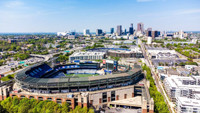
2024 © Georgia State Panthers 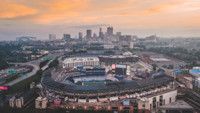
2023 © Georgia State Panthers 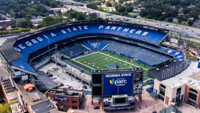
2024 © Georgia State Panthers 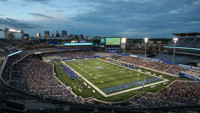
2019 © Georgia State Panthers 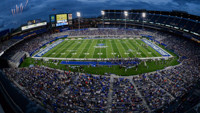
2017 © Georgia State Panthers 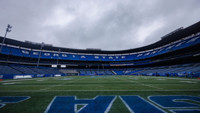
2024 © Georgia State Panthers
 StadiumDB
StadiumDB